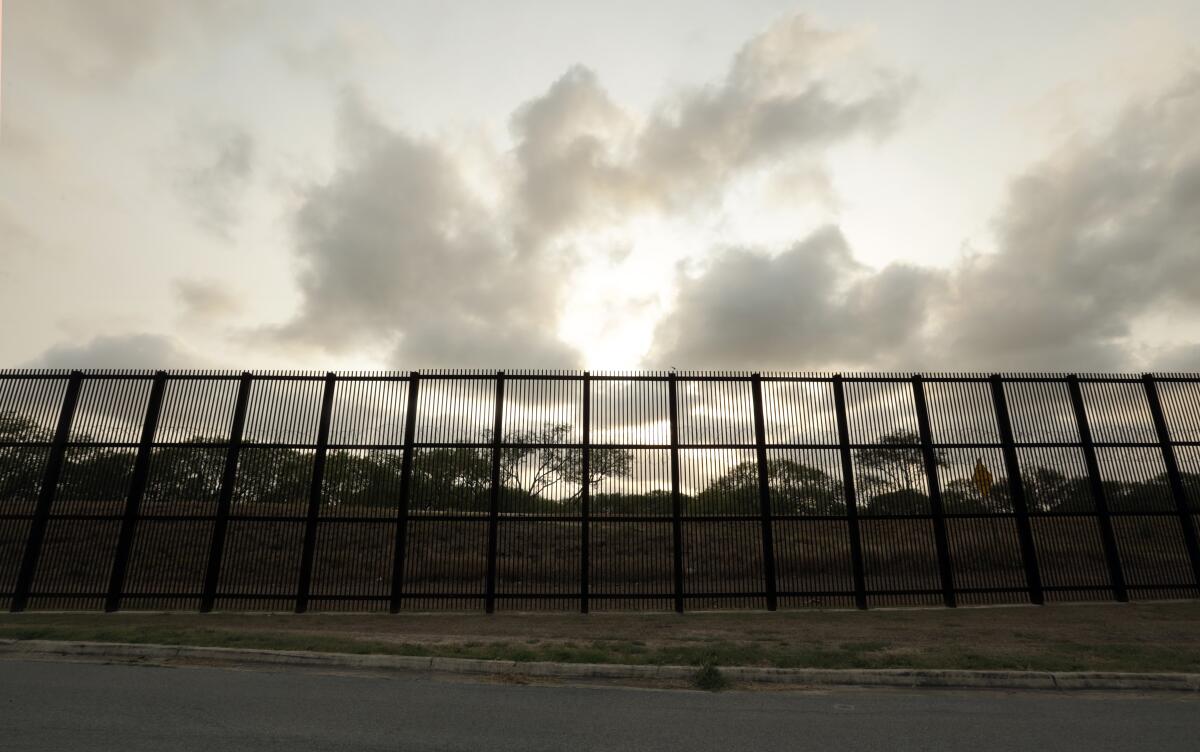Column: Biden’s border surveillance empire should scare you regardless of politics

President Biden largely halted construction on his predecessor’s border wall, which Democrats decried as inhumane. But he never stopped the Department of Homeland Security from using the border as a testing ground for dystopian military and surveillance technologies — including, most recently, headless robot dogs.
This month, DHS pitched the robot dogs as fun, futuristic versions of “man’s best friend,” meant to help Border Patrol agents navigate rough terrain and other threats. Critics argue that they look like the human-hunting ones in the Netflix series “Black Mirror,” and that they’d frighten families seeking refuge in this country. The company that makes them, Ghost Robotics, has showcased similar robot dogs equipped with firearms.
Opinion Columnist
Jean Guerrero
Jean Guerrero is the author, most recently, of “Hatemonger: Stephen Miller, Donald Trump and the White Nationalist Agenda.”
Whether you think these canines are creepy or cute, the fact is that the deployment of surveillance technologies at the border — including sensors, drones and camera-equipped towers — has historically pushed people seeking work or asylum in the U.S. into more dangerous remote crossing routes, where thousands have died.
“It’s very much the same type of enforcement that criminalizes migration and makes it more deadly,” Jacinta González, senior campaign director for the racial justice group Mijente, told me.
These so-called smart technologies — which Biden touted from his first day in office — have also tended to spill from the border into the country’s interior. For example, in 2020, border drones and other aerial surveillance tools were used by DHS to monitor anti-racist protesters in more than 15 cities.
Similarly, license-plate-scanning technology that started at the border in the 1990s is now common across police departments.
A growing network of self-proclaimed social media ‘reporters’ is fueling the QAnon delusion, using sex trafficking of migrant children as part of the conspiracy.
“A lot of people who’d normally oppose intrusive government technologies and programs are just fine with it because of their antipathy to immigrants,” Jay Stanley, a senior policy analyst at the American Civil Liberties Union, told me.
The ACLU has raised concerns about these technologies, noting a “vast potential for abuse, as law-abiding citizens in border areas may not be aware that they are being monitored.”
Mijente and other groups have documented the proliferation of high-tech border infrastructure in marginalized communities and its disproportionate impact on Black and Indigenous people.
But the borderlands surveillance empire — which lacks oversight because of its largely rural nature — imperils everyone. It’s driven by companies that deserve scrutiny.
For example, in 2019, the Tohono O’odham Nation became the designated site for surveillance towers built by Israel’s military company Elbit Systems, whose activities affecting Palestinians have triggered human rights concerns and divestment.
“Technology companies that were for a long time making a huge profit off of investment in [wars] abroad are now bringing that technology to our militarized border as a way of experimenting how far they can normalize this before making it widespread throughout the United States,” González told me.
While the term Latinx is imperfect, the idea that it was invented by performative ‘woke’ whites erases the voices who forged it as a path to visibility.
The border has also attracted venture capitalists such as the billionaire and Trump supporter Peter Thiel, who funded the Irvine-based company Anduril, which has won government contracts worth hundreds of millions of dollars to build 200 sensor towers all along the border.
Instead of creating a humane immigration system that might begin to address the reality of migration, the Biden administration is continuing a bipartisan legacy of throwing insane amounts of money at military-style border technology.
These expenditures promote the fantasy of the border as a war zone overwhelmed by criminals and cartels, when the reality is that most people Border Patrol encounters are parents and children seeking asylum.
In promoting military and surveillance technologies, DHS conflates immigration with terrorism. The department’s Science and Technology Directorate article about the robot dogs likened them to “force multipliers” and conjured the presence of “WMD,” or weapons of mass destruction. (I asked DHS how many such weapons agents have found at the border, but did not receive a response in time for this column; the State Department previously said there is no credible information that known terrorists have traveled through Mexico to access the U.S.)
Amid a surge in high-tech gadgets for use on people crossing the border, technology for detecting sophisticated cartel infrastructure — such as underground drug tunnels — flounders.
Gil Kerlikowske, Customs and Border Protection commissioner in the Obama administration, recalls asking the Science and Technology Directorate to help develop such tools during his tenure. “Unfortunately, there was no answer from them,” he told me. “In a way, S&T had a bit of a mind of their own.”
Dave Maass, the investigations director at Electronic Frontier Foundation, believes the “highly politicized nature” of DHS, which inclines many of its employees toward activities that showcase their power, means it’s “more susceptible to products that can be packaged for press releases or TV.” A DHS spokesperson told me that the robot dog project is still in a “research and development phase” and that they’re not meant to “engage with migrants.”
Last year, the New York City Police Department canceled a contract for similar robot dogs after public outrage.
DHS has a documented problem of migrant abuse, extremism and white supremacist views in its ranks. Its members have targeted attorneys, journalists and others for questioning without cause. Their access to technologies powered by artificial intelligence — from iris scanning to racially discriminatory facial recognition — raises serious ethical questions.
Given the global rise of authoritarianism, and the known use of surveillance technologies for oppression abroad, it’s imperative that the U.S. develop a bill of rights regulating their use here. In the meantime, lawmakers should slash DHS funding for these technologies, recognizing that they are just as deadly as then-President Trump’s wall — with greater potential for abuse.
More to Read
A cure for the common opinion
Get thought-provoking perspectives with our weekly newsletter.
You may occasionally receive promotional content from the Los Angeles Times.













